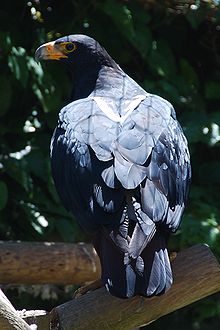Verreaux's Eagle
| Verreaux's Eagle | |
|---|---|
 | |
| Conservation status | |
| Scientific classification | |
| Kingdom: | Animalia |
| Phylum: | Chordata |
| Class: | Aves |
| Order: | Accipitriformes |
| Family: | Accipitridae |
| Genus: | Aquila |
| Species: | A. verreauxii |
| Binomial name | |
| Aquila verreauxii Lesson, 1830 | |
 | |
| Range of Verreaux's Eagle in green | |
Verreaux's Eagle (Aquila verreauxii), alternatively known as the Black Eagle (leading to confusion with the Asian Black Eagle), is a large bird of prey. This eagle lives in hilly and mountaineous regions of southern and eastern Africa (extending marginally into Chad), and very locally in Western Asia.
Description
It is 75 to 96 cm (30 to 38 in) long. Males weigh 3 to 4.2 kg (6.6 to 9.3 lb) and females weigh 3.1 to 5.8 kg (6.8 to 13 lb). It has a wingspan of 1.81 to 2.2 m (5.9 to 7.2 ft). It is black with a distinct white V marking on its back.Juveniles are usually light and dark brown with a black face. Structurally, it is very similar to the Golden Eagle of the Northern Hemisphere, and the Wedge-tailed Eagle of Australia.
Ecology
Feeding
It is a specialist hunter of hyraxes (or dassies). The size of its territory often inversely reflects the size of the local hyrax population. Occasionally, it will prey on ground birds such as guineafowl orfrancolin and mammals of similar size to hyraxes, such as large rodents. There are reports stating that the Verreaux's Eagle also preys on monkeys, small antelope and seldomly on reptiles andcarrion. It hunts its prey by swooping around the corners of cliffs and thus surprising it prey by its sudden appearance. It also stoops from a perch; although this method is used less often. A pair of Verreaux's Eagle may hunt cooperatively. This eagle on rare occasions may pirate food from other raptors, including Bearded Vulture and other eagles.
Breeding
It is highly territorial and can often be seen with another Verreaux's Eagle, with whom it mates for life. The pair will lay two cream-colored eggs, four days apart in autumn, and these will hatch approximately 45 days later. In Southern Africa the breeding season stretches from April to June, sometimes into August. Its nest is a huge stick-nest platform in the shape of a platform. The nest's diameter is about 1.5-2m. The 30–40 cm diameter bowl is lined with green leaves. The nest is usually situated on a cliff ledge, rarely in a tree. The nest site is generally marked by a 'whitewash' which is formed by the birds' droppings.
The name commemorates the French naturalist Jules Verreaux, who visited southern Africa in the early 18th century.




No comments:
Post a Comment